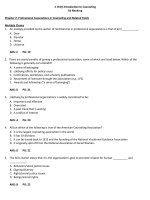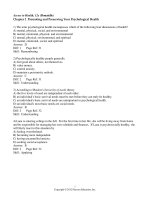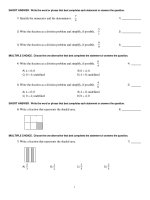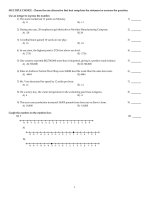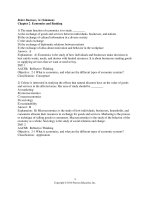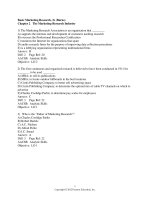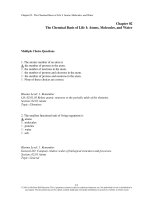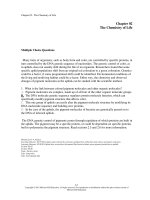Nutritional sciences from fundamentals to food 3rd edition shelley test bank
Bạn đang xem bản rút gọn của tài liệu. Xem và tải ngay bản đầy đủ của tài liệu tại đây (435.75 KB, 18 trang )
281
Chapter 2 – Nutritional Assessment and Dietary Planning
Multiple Choice
Answer, level, page
Level: K = knowledge, A = application/critical thinking
What Do We Mean by “Nutritional Status”? (pp. 33-34)
a
K
33
1.
Undernutrition and overnutrition both are examples of
a. malnutrition.
b. nutritional deficiency.
c. nutritional toxicity.
d. overconsumption.
e. underconsumption.
d
K
33
2.
Overconsumption of a nutrient resulting in dangerous effects is termed:
a. overload.
b. obesity.
c. nutritional excess.
d. nutritional toxicity.
b
K
33
3.
If a person had an iron deficiency because of an inadequate intake of iron-rich foods,
which type of malnutrition could this be classified as?
a. Combination-state malnutrition
b. Primary malnutrition
c. Secondary malnutrition
d. Protein malnutrition
b
K
33-34
4.
Mrs. Jones is recovering from gastric bypass surgery, and as a result has become deficient
in a number of nutrients. Which type of malnutrition is Mrs. Jones experiencing?
a. Primary
b. Secondary
c. Post-surgical
d. Multiple state
How Is Nutritional Status Assessed? (pp. 34-38)
e
K
34
5.
Nutritional status assessment includes:
a. dietary assessment.
b. clinical assessment.
c. biochemical assessment.
d. anthropometric assessment.
e. All of the above
a
K
34
6.
Estimates of physical aspects of the body such as body composition are categorized as
_____ measurements.
a. anthropometric
b. biochemical
c. clinical
d. dietary
© 2013 Cengage Learning. All Rights Reserved. May not be copied, scanned, or duplicated, in whole or in part, except for use as permitted in a
license distributed with a certain product or service or otherwise on a password-protected website for classroom use.
282
b
K
35
7.
A measurement, such as in blood or urine, that reflects a nutrient’s function is termed:
a. an anthropometric marker.
b. a biological marker.
c. a clinical marker.
d. a physical marker.
a
K
35
8.
Height and weight are examples of which type of measurements?
a. Anthropometric
b. Biochemical
c. Clinical
d. Dietary
c
K
35
9.
An estimate of your _____, the proportions of lean tissue, body fat, water, and mineral
(bone) mass, can help determine your nutritional status.
a. body weight
b. body height
c. body composition
d. body mass index
b
K
35
10. Which of the following measures body fat distribution?
a. Head circumference
b. Waist and hip circumferences
c. Mid-arm muscle circumference
d. Frame size
b
K
35
11. A blood glucose level is an example of which of the following measures?
a. Anthropometric
b. Biochemical
c. Clinical
d. Dietary
c
K
36
12. “Skin and bone appearance” would reflect which of the following forms of nutritional
status assessment?
a. Anthropometric
b. Biochemical
c. Clinical
d. Dietary
c
K
36
13. A physical examination during nutritional assessment is considered a(n)
a. anthropometric measurement.
b. biochemical assessment.
c. clinical assessment.
d. dietary assessment.
a
K
36
14. Of the following, which would be considered a symptom?
a. Loss of appetite
b. Swollen ankles
c. Skin rash
d. Difficulty breathing
d
K
36
15. Clinical assessment to determine a person’s nutritional status would include which of the
following?
a. Height and weight
b. Blood and/or urine sample
c. Diet history
d. Medical history
© 2013 Cengage Learning. All Rights Reserved. May not be copied, scanned, or duplicated, in whole or in part, except for use as permitted in a
license distributed with a certain product or service or otherwise on a password-protected website for classroom use.
283
d
K
37
16. A _____ is a retrospective dietary assessment method which asks a person to quantify
how often and in what amounts they eat or drink a specific food over a period of time.
a. 7-day diet record
b. 24-hour recall
c. diet history
d. food frequency questionnaire
d
K
37
17. An example of a prospective method of dietary assessment would be a:
a. 24-hour recall.
b. food frequency questionnaire.
c. diet history.
d. 3-day diet record.
a
K
37
18. Which method of assessing dietary intake is most accurate and requires food and
beverages to be recorded as they are consumed?
a. diet record
b. 24-hour recall
c. diet history
d. food frequency questionnaire
c
K
37
19. Which of the following is not true about diet records?
a. Food portion sizes must be estimated using standard household measurements (such
as tablespoons or cups) or weighed prior to consumption
b. Food records may be conducted by medical professionals or as self-assessments
c. A food record’s accuracy depends on the individual’s memory
d. Food records should be kept for 3 days, one which should be a weekend day
b
A
37
20. As a registered dietitian, you want to better understand the typical eating patterns of your
client. Therefore, you plan to administer a:
a. 24-hour recall.
b. food frequency questionnaire.
c. dietary record.
d. physical exam.
b
K
37
21. What method is considered easy to use should you wish to determine the micronutrient,
macronutrient, and energy (calorie) content of your diet?
a. Food composition tables
b. Computerized nutrient databases
c. Dietary Reference Intakes
d. Nutrition Fact labels
How Much of a Nutrient Is Adequate? (pp. 38-46)
b
K
38
22. Which agency established the Dietary Reference Intakes (DRIs) for macronutrients?
a. United States Department of Agriculture (USDA)
b. Institute of Medicine (IOM)
c. Food and Drug Administration (FDA)
d. Health and Human Services Organization (HHSO)
c
K
38
23. What were the first dietary standards published in 1943 by the National Academy of
Sciences called?
a. Reference Daily Intakes (RDIs)
b. Reference Dietary Intakes (RDIs)
c. Recommended Dietary Allowances (RDAs)
d. Recommended Daily Allowances (RDAs)
© 2013 Cengage Learning. All Rights Reserved. May not be copied, scanned, or duplicated, in whole or in part, except for use as permitted in a
license distributed with a certain product or service or otherwise on a password-protected website for classroom use.
284
a
K
39-40
24. The RDAs were originally designed primarily to:
a. prevent nutrient deficiencies.
b. reduce risk of chronic disease.
c. correct nutrient deficiencies.
d. prevent overnutrition.
b
K
38, 40
25. “_____” is a term used to describe a set of four groups of values: EARs, RDAs, AIs, and
ULs.
a. Daily Reference Intakes (DRIs)
b. Dietary Reference Intakes (DRIs)
c. Reference Daily Intakes (RDIs)
d. Reference Dietary Intakes (RDIs)
b
K
40
26. A nutrient _____ is the amount of a nutrient that must be consumed to prevent
deficiencies; it is determined by a person’s nutritional needs based on a host of factors
such as sex, age, physical activity, and genetics.
a. status
b. requirement
c. adequacy
d. intake
a
K
41
27. The _____ for a particular nutrient is the intake value thought to meet the requirement of
half the healthy individuals of the same gender who are in a particular stage of life.
a. Estimated Average Requirement (EAR)
b. Recommended Dietary Allowance (RDA)
c. Recommended Daily Allowance (RDA)
d. Adequate Intake Level (AI)
b
K
42
28. The EARs are very useful in research settings for evaluation of whether a group of people
is likely to be consuming adequate amounts of a nutrient. Therefore, it is _____ to use the
EAR values as recommended goals for dietary intake of an individual.
a. appropriate
b. inappropriate
c. recommended
d. required
a
K
41-42
29. Only 50% of healthy individuals will have their physiological needs met at which level of
intake?
a. EAR
b. RDA
c. AI
d. UL
d
K
42
30. The _____ for a particular nutrient is the daily dietary intake level considered sufficient
to meet the nutrient requirements of nearly all healthy individuals (about 97%) of the
same gender who are in a particular stage of life.
a. Estimated Average Requirement (EAR)
b. Tolerable Upper Intake Level (UL)
c. Adequate Intake (AI)
d. Recommended Dietary Allowance (RDA)
© 2013 Cengage Learning. All Rights Reserved. May not be copied, scanned, or duplicated, in whole or in part, except for use as permitted in a
license distributed with a certain product or service or otherwise on a password-protected website for classroom use.
285
c
K
43
31. When scientific evidence was insufficient to establish an EAR and thus accurately set an
RDA, the DRI committee derived a(n) _____ instead.
a. Estimated Average Requirement (EAR)
b. Tolerable Upper Intake Level (UL)
c. Adequate Intake (AI)
d. Recommended Dietary Allowance (RDA)
c
K
43
32. _____ are meant to be used as nutrient intake goals for individuals, because they were
based on experimentally documented intake levels of a nutrient that seemed to maintain
adequate nutritional status in healthy people.
a. Estimated Average Requirements (EARs)
b. Recommended Dietary Allowances (RDAs)
c. Adequate Intakes (AIs)
d. Estimated Energy Requirements (EERs)
a
K
43
33. An example of a nutrient with an AI instead of an RDA is:
a. sodium.
b. vitamin A.
c. folate.
d. iron.
b
K
43
34. The _____ provide limits for those who take supplements or consume large amounts of
fortified foods.
a. Estimated Average Requirements (EARs)
b. Tolerable Upper Intake Levels (ULs)
c. Adequate Intakes (AIs)
d. Recommended Dietary Allowances (RDAs)
a
A
44
35. A 25-year-old woman has recently visited a registered dietitian as part of a routine health
exam. She is consuming less than the EAR for nutrient x. Her intake for that nutrient is:
a. probably inadequate.
b. possibly inadequate.
c. probably adequate.
d. more than adequate.
e. None of the above
b
A
44
36. A 25-year-old woman has recently visited a registered dietitian as part of a routine health
exam. She is consuming less than the RDA for nutrient x. Her intake for that nutrient is:
a. probably inadequate.
b. possibly inadequate.
c. probably adequate.
d. more than adequate.
e. None of the above
c
A
44
37. A 25-year-old woman has recently visited a registered dietitian as part of a routine health
exam. She is consuming more than the RDA, yet less than the UL, for nutrient x. Her
intake for that nutrient is:
a. probably inadequate.
b. possibly inadequate.
c. probably adequate.
d. more than adequate.
e. None of the above
© 2013 Cengage Learning. All Rights Reserved. May not be copied, scanned, or duplicated, in whole or in part, except for use as permitted in a
license distributed with a certain product or service or otherwise on a password-protected website for classroom use.
286
b
K
44
38. If intake of a nutrient is between the EAR and the RDA, then it:
a. could be reduced.
b. should probably be increased.
c. is adequate.
d. is more than adequate.
a
K
44
39. If intake of a nutrient in the diet falls below the AI, then:
a. more information is needed to determine the adequacy of diet.
b. the diet is inadequate.
c. the diet is poor.
d. the diet is probably adequate.
b
K
45
40. You are a sophomore in college and are calculating your EER. Your activity level has
decreased significantly since your freshman year. You would expect your current EER to
be _____ when compared to your freshman year.
a. higher
b. lower
c. no different
a
K
45
41. Which of the following physical activity factors would be appropriate to use when
calculating the EER for a sedentary man and/or woman?
a. 1.0
b. 1.11
c. 1.25
d. 1.48
c
A
45
42. A female college student who weighs 110 lbs would weigh _____ kilograms.
a. 43
b. 45
c. 50
d. 55
e
K
45
43. Energy requirements for individuals are influenced by
a. age and gender.
b. weight and height.
c. level of physical activity.
d. a and b
e. all of the above
c
K
46
44. What is the Acceptable Macronutrient Distribution Range (AMDR) for carbohydrates, as
a percentage of total energy?
a. 40%-60%
b. 45%-60%
c. 45%-65%
d. 50%-65%
How Can You Easily Assess and Plan Your Diet? (pp. 46-48)
b
K
47
45. When did the USDA begin publishing nutritional recommendations for Americans?
a. 1849
b. 1894
c. 1943
d. 1961
© 2013 Cengage Learning. All Rights Reserved. May not be copied, scanned, or duplicated, in whole or in part, except for use as permitted in a
license distributed with a certain product or service or otherwise on a password-protected website for classroom use.
287
c
K
47
46. What is the term for the succession of federally supported recommendations designed to
provide guidelines for dietary planning?
a. Dietary Guidelines
b. Basic 4
c. Food Guides/Food Patterns
d. Meal Planning
a
K
47-48
47. During the depression era the focus of the USDA’s food guide was to recommend:
a. high-fat foods such as milk, peanuts, and cheese.
b. carbohydrate foods such as breads and cereals.
c. garden-fresh foods such as fruits and vegetables.
d. high-sugar foods such as cake, pie, and cookies.
c
K
48
48. How often are the Dietary Guidelines for Americans revised?
a. Every year
b. Every 3 years
c. Every 5 years
d. Every 10 years
d
K
48
49. Which organization publishes both the Dietary Guidelines for Americans and the
MyPlate graphic?
a. American Dietetic Association (ADA)
b. Food and Drug Administration (FDA)
c. World Health Organization (WHO)
d. United States Department of Agriculture (USDA)
2010 Dietary Guidelines for Americans: Our Current Recommendations (pp. 48-58)
a
K
48-49
50. The 2010 Dietary Guidelines for Americans emphasize four key concepts. Which of the
following is not one of them?
a. Reduce calories to maintain weight
b. Reduce certain food and food components
c. Increase certain foods and nutrients
d. Build healthy eating patterns
a
K
50
51. To determine personal energy requirements, you can calculate your _____, which has
been published as part of the DRI and designed for this purpose.
a. Estimated Energy Requirement (EER)
b. Basal Energy Expenditure (BEE)
c. Total Resting Energy Expenditure (TEE)
d. Personal Energy Expenditure (PEE)
c
K
50
52. The 2010 Dietary Guidelines identified several “nutrients of concern” that are known to
be somewhat lacking in the American diet. They are:
a. iron, calcium, phosphorus, and zinc.
b. iron, calcium, vitamin D, and vitamin A.
c. potassium, dietary fiber, calcium, and vitamin D.
d. potassium, dietary fiber, phosphorus, and vitamin D.
b
K
52
53. At breakfast Jane makes sure she gets as many nutrients as she can for every calorie she
consumes. Jane’s breakfast would be considered:
a. low calorie.
b. nutrient dense.
c. high calorie.
d. well balanced.
© 2013 Cengage Learning. All Rights Reserved. May not be copied, scanned, or duplicated, in whole or in part, except for use as permitted in a
license distributed with a certain product or service or otherwise on a password-protected website for classroom use.
288
c
K
52
54. How many Food Patterns were developed by the USDA to correspond to the energy
intake levels on which MyPlate was based?
a. 8
b. 10
c. 12
d. 14
a
A
52, 53
55. You want to choose the most nutrient-dense food to improve your vitamin C intake. You
are deciding between ¾ cup of fresh orange juice (84 kcal, 93 mg vitamin C), 1 cup of
fresh pink grapefruit juice (96 kcal, 94 mg of vitamin C), and 1 cup canned apple juice
(117 kcal, 2 mg vitamin C). Which is the best choice?
a. Orange juice
b. Grapefruit juice
c. Apple juice
d. All are equal
a
A
52-53
56. Which one of the following food items would have the highest nutrient density for
calcium?
a. Skim milk
b. 1% milk
c. 2% milk
d. Whole milk
a
A
52-53
57. Which one of the following food items is the most nutrient dense?
a. Fresh peaches
b. Canned peaches in syrup
c. Peach pie
d. Peach preserves
a
K
52
58. Which one of the following food groups is a major source of B vitamins?
a. Grains
b. Vegetables
c. Fruits
d. Dairy products
e
K
50
59. The Dietary Guidelines recommend that individuals control their calorie intake by which
of the following methods?
a. Increasing intake of whole grains
b. Increasing consumption of fruits and vegetables
c. Reducing intake of sugar-sweetened beverages
d. Monitoring calorie intake from alcoholic beverages
e. All of the above
c
K
52
60. If the results of a nutritional analysis revealed an inadequate intake of calcium, vitamin
D, and protein, increased intakes of which one of the following food groups, by itself,
could help correct this situation?
a. Grains
b. Protein foods
c. Dairy
d. Vegetables
a
K
53
61. The type of beverage most commonly consumed by U.S. adults contains:
a. sugar and water (i.e., regular soda).
b. caffeine and fat (i.e., coffee latte).
c. sugar and electrolytes (i.e., sports drink).
d. alcohol (i.e., beer, wine, hard liquor).
© 2013 Cengage Learning. All Rights Reserved. May not be copied, scanned, or duplicated, in whole or in part, except for use as permitted in a
license distributed with a certain product or service or otherwise on a password-protected website for classroom use.
289
a
K
53
62. How many Calories per day are typically supplied in the U.S. diet by low-nutrient dense
drinks?
a. 120
b. 160
c. 240
d. 320
b
K
54
63. What icon appearing in the MyPlate graphic represents dairy products?
a. Red wedge
b. Blue circle
c. Yellow circle
d. Green wedge
c
K
54-55
64. MyPlate, a mealtime visual, illustrates daily intakes of the four food groups
proportionately on the plate with dairy intake represented by the round glass or bowl on
the upper right periphery of the plate. Which one of the following food groups should
make up half your plate?
a. Vegetables and Grains
b. Meat and Grains
c. Fruits and Vegetables
d. Protein and Dairy
b
K
57
65. The U.S. Department of Health and Human Services developed a set of overall health
objectives for the nation. What is this document called?
a. Dietary Guidelines for Americans 2010
b. Healthy People 2020
c. Healthy Nation 2020
d. Surgeon General’s Report 2010
d
K
57
66. How often are Healthy People documents published?
a. Every year
b. Every 3 years
c. Every 5 years
d. Every 10 years
a
K
57
67. Many topics and goals formulated for Healthy People 2020 are consistent with
recommendations put forth in:
a. the 2010 Dietary Guidelines for Americans.
b. USDA’s MyPlate guidance plan.
c. the Surgeon General’s Report 2010.
d. the Dietary Reference Intakes (DRIs).
How Can You Use Food Labels to Plan a Healthy Diet? (pp. 58-64)
b
K
58
68. The regulation of nutrition labeling for foods was established by in 1973 by the _____.
a. USDA
b. FDA
c. HHS
d. WHO
c
K
58
69. On a food label, the product’s ingredient contents are listed:
a. in alphabetical order.
b. with the most important nutrient sources first.
c. from most abundant to least abundant ingredient by weight.
d. from least abundant to most abundant ingredient by volume.
© 2013 Cengage Learning. All Rights Reserved. May not be copied, scanned, or duplicated, in whole or in part, except for use as permitted in a
license distributed with a certain product or service or otherwise on a password-protected website for classroom use.
290
e
A
58
70. Suppose you are a registered dietitian working for a food manufacturer. By law the label
that you are working on for a new product must include the:
a. product picture.
b. product name and place of business.
c. product net weight and ingredient content.
d. a and b
e. b and c
d
K
59
71. Which of the following nutrients is not required on the Nutrition Facts panel?
a. Total fat
b. Saturated fat
c. Sodium
d. Potassium
d
A
60
72. Which of the following is not a kosher standard?
a. Food made from pigs or rabbits can never be kosher.
b. Only people who are trained and qualified are allowed to slaughter kosher animals.
c. To be considered kosher, meat and dairy products cannot be prepared or served
together on the same plate.
d. Whereas some shellfish can be kosher, fish are not.
b
A
59,61
73. If you drank a 20-ounce bottle of soda and the serving size is 8 ounces, how many
servings would you have consumed?
a. 2
b. 2.5
c. 3
d. 3.5
d
A
59, 61
74. A 20-ounce bottle of soda would contain how many grams of carbohydrate based on the
following information: 30 grams sugar per 8-oz. serving?
a. 30 grams
b. 45 grams
c. 60 grams
d. 75 grams
c
A
59,61
75. You want to select a cereal that has less than 150 kcal per serving and at least 5 grams of
dietary fiber. Therefore, you refer to the:
a. product ingredient list.
b. product code.
c. Nutrition Facts panel.
d. Dietary Reference Intakes.
c
K
60
76. What reference values were created specifically for the Nutrition Facts label to give
consumers a benchmark with which to compare nutrients?
a. Reference Values (RV)
b. Recommended Values (RV)
c. Daily Values (DV)
d. Dietary Values (DV)
c
A
61
77. If one serving of cereal provides 67% of an “average” person’s DV for vitamin C, how
much vitamin C does one serving of cereal contain?
a. 20 mg
b. 30 mg
c. 40 mg
d. 50 mg
© 2013 Cengage Learning. All Rights Reserved. May not be copied, scanned, or duplicated, in whole or in part, except for use as permitted in a
license distributed with a certain product or service or otherwise on a password-protected website for classroom use.
291
c
K
60-61
78. Which of the following represent recommended intakes of nutrients based specifically on
a 2,000- and a 2,500-kcalorie diet?
a. RDI
b. DRI
c. DV
d. RDA
d
A
61
79. Based on a reference diet of 2,000 Calories, what percentage of the daily value (%DV)
for carbohydrate is provided by a 1-cup serving of macaroni and cheese that contains 60
grams of carbohydrate per serving?
a. 12
b. 15
c. 17
d. 20
a
K
63
80. You are comparing two varieties of fudge-striped cookies. The regular cookies provide
150 kcal per serving. In order for the “light” cookies to be labeled with the claim
“reduced calorie,” they must contain _____ or fewer calories per serving.
a. 113
b. 75
c. 37
d. 25
b
K
63
81. The FDA- approved nutrient content claim “calorie free” means that a food product
contains _____ kcalories (Calories) per serving.
a. 0
b. < 5
c. < 10
d. < 25
b
K
63
82. A food product that claims to be “low in fat” must contain _____ gram(s) of fat or less
per serving.
a. 1
b. 3
c. 5
d. 7
c
K
64
83. A claim that can legally be included on a food’s packaging to describe a specific,
scientifically supported health benefit is called a _____ claim.
a. nutrient content
b. health benefit
c. regular health
d. qualified health
b
K
64
84. _____ are statements concerning less well-established health benefits that have been
ascribed to a particular food or food component.
a. Regular health claims
b. Qualified health claims
c. Nutrient content claims
d. Nutritional benefit claims
© 2013 Cengage Learning. All Rights Reserved. May not be copied, scanned, or duplicated, in whole or in part, except for use as permitted in a
license distributed with a certain product or service or otherwise on a password-protected website for classroom use.
292
For questions 85-94, refer to the Bran Flakes with Raisins Nutrition Facts label.
Bran Flakes with Raisins label
Nutrition Facts
Serving Size 1 cup (59g)
Servings Per Container ~10
Amount Per Serving
Calories 190
Calories from Fat 10
% Daily Value*
Total Fat 1g
Saturated Fat 0g
Trans Fat 0g
Cholesterol 0mg
Sodium 300mg
Total Carbohydrate 46g
Dietary Fiber 8g
Sugars 19g
Protein 4g
Vitamin A 15%
Calcium 2%
•
•
2%
0%
0%
12%
15%
32%
Vitamin C 0%
Iron 60%
* Percent Daily Values are based on a 2,000 calorie diet.
Your Daily Values may be higher or lower depending on
your calorie n eeds.
Calories
2,000
2,500
Total Fat
Less than
65g
80g
Sat Fat
Less than
20g
25g
Cholesterol
Less than
300mg
300mg
Sodium
Less than
2400mg
2400mg
Total Carbohydrate
300g
375g
Dietary Fiber
25g
30g
c
A
59, 61
85. If you ate a large bowl (~1.5 cups) of the Bran Flakes with Raisins cereal, how many
Calories did you consume from the cereal (not including the milk)?
a. 190 Calories
b. 270 Calories
c. 285 Calories
d. 380 Calories
c
A
59, 61
86. If you ate a large bowl (~1.5 cups) of the Bran Flakes with Raisins cereal, how many
grams of fiber did you consume from the cereal?
a. 4 grams
b. 8 grams
c. 12 grams
d. 16 grams
c
A
60-61
87. If you ate a large bowl (~1.5 cups) of the Bran Flakes with Raisins cereal, what % of the
Daily Value (%DV) of fiber is being provided based on a 2000-kcal diet?
a. 12
b. 32
c. 48
d. 64
© 2013 Cengage Learning. All Rights Reserved. May not be copied, scanned, or duplicated, in whole or in part, except for use as permitted in a
license distributed with a certain product or service or otherwise on a password-protected website for classroom use.
293
c
A
60-61
88. If you ate a large bowl (~1.5 cups) of the Bran Flakes with Raisins cereal, what % of the
Daily Value (DV) for iron would this amount provide, based on a 2000-kcal diet?
a. 30
b. 60
c. 90
d. 120
d
A
60-61
89. How many cups of the Bran Flakes with Raisins cereal would you need to consume in a
day to meet your % DV for vitamin A based on a 2000-kcal diet?
a. Between 3 and 4 cups
b. Between 4 and 5 cups
c. Between 5 and 6 cups
d. Between 6 and 7 cups
c
A
59, 61
90. If there are 4 grams of carbohydrates in a teaspoon of sugar, how many teaspoons of
sugar are there in 2 cups of Bran Flakes with Raisins cereal?
a. 4.5 teaspoons
b. 6 teaspoons
c. 9.5 teaspoons
d. 11 teaspoons
d
A
60-61
91. If you ate 2 servings of the Bran Flakes with Raisins cereal, what % of the Daily Value
for sodium would this provide, based on a 2000-kcal diet?
a. 9
b. 45
c. 15
d. 24
a
A
59, 61
92. If you consumed 2 cups of cereal daily at breakfast, when would you have to purchase a
box of Bran Flakes with Raisins cereal again?
a. On the 5th day
b. On the 7th day
c. On the 10th day
d. On the 14th day
c
A
60-61
93. If you ate a one (1) serving of the Bran Flakes with Raisins cereal, what % of the Daily
Value for vitamin A would this provide, based on a 2000-kcal diet?
a. 0
b. 2
c. 15
d. 60
d
A
62
94. According to the Nutrition Facts panel, Bran Flakes with Raisins cereal is an excellent
source of which nutrient?
a. Vitamin A
b. Calcium
c. Protein
d. Iron
© 2013 Cengage Learning. All Rights Reserved. May not be copied, scanned, or duplicated, in whole or in part, except for use as permitted in a
license distributed with a certain product or service or otherwise on a password-protected website for classroom use.
294
Can You Put These Concepts into Action? (pp. 64-66)
c
A
64-65
95. Jodi’s nutritional intake for one day revealed the following: 2010 kcalories, 90 g of fat,
80 g protein, and 220 g of carbohydrate. Jodi’s fat intake is:
a. 30% of total kcalories.
b. 35% of total kcalories.
c. 40% of total kcalories.
d. 45% of total kcalories.
b
A
64-65
96. Jodi’s nutritional intake for one day revealed the following: 2010 kcalories, 90 g of fat,
80 g protein, and 220 g of carbohydrate. Jodi’s protein intake is:
a. 8% of total kcalories.
b. 16% of total kcalories.
c. 24% of total kcalories.
d. 32% of total kcalories.
a
A
64-65
97. Jodi’s nutritional intake for one day revealed the following: 2010 kcalories, 90 g of fat,
80 g protein, and 220 g of carbohydrate. Jodi’s carbohydrate intake is:
a. 44% of total kcalories.
b. 48% of total kcalories.
c. 52% of total kcalories.
d. 56% of total kcalories.
a
A
52, 65
98. The results of Jodi’s dietary analysis indicate that her fiber, iron, and B 12 intakes are low.
Which choice below would help provide Jodi with these missing nutrients?
a. Fortified cereal with 1% milk
b. Apple with creamy peanut butter
c. Low-fat fruited yogurt
d. Cheese and crackers
a
A
64-65
99. After reviewing her nutritional analysis, Jodi now believes she understands why she
might have been feeling so tired. She learned that:
a. she needs to increase her iron and vitamin B 12 intakes, as both are needed for energy
production.
b. she needs to increase her fiber intake; not eating enough whole grains was not giving
her enough energy.
c. her fat intake was too high and she couldn’t get the energy she needed.
d. she wasn’t getting enough total calories.
d
A
66
100. In order to help you choose a diet that fits your personal nutritional needs, which of the
following reference standards could you use?
a. Dietary Reference Intakes (DRI)
b. Dietary Guidelines
c. Nutrition Facts panel
d. All of the above
True/False
Answer, level, page
F
A
33
1.
Taking megasupplements of essential vitamins is vital for maintaining health and
adequate nutritional status.
T
K
35
2.
Body composition is the proportions of fat, water, lean tissue, and mineral mass that
make up your tissues.
© 2013 Cengage Learning. All Rights Reserved. May not be copied, scanned, or duplicated, in whole or in part, except for use as permitted in a
license distributed with a certain product or service or otherwise on a password-protected website for classroom use.
295
F
K
38, 42
3.
The Recommended Daily Allowances are dietary intake standards for the U.S. and
Canada.
F
K
41, 43
4.
The EAR and UL are used to examine the likelihood of dietary excess and adequacy,
respectively.
F
K
42-43
5.
The RDAs are derived from AIs.
T
A
43-44
6.
Dietary intake goals for a nutrient with an RDA and UL should be set at the RDA, but
less than the UL.
F
K
43
7.
Tolerable Upper Intake Levels were developed to decrease risk of adverse health effects
from inadequate intakes of a nutrient.
F
K
49
8.
The 2010 Dietary Guidelines for Americans forbid consumption of alcohol.
F
K
49
9.
According to the Dietary Guidelines for Americans, fruit, vegetable, and whole grain
intakes should be increased, while intake of nonfat or low-fat milk and milk products
should be decreased.
T
K
52
10. Dairy products are significant sources of calcium, potassium, vitamins, and protein.
T
K
53
11. Baked chicken is more nutrient dense than fried chicken.
T
K
54
12. MyPlate translates into practice the USDA’s 2010 Dietary Guidelines for Americans.
F
K
54
13. Grains are the foundation of MyPlate.
T
K
54
14. The ChooseMyPlate.gov website allows visitors to access personalized dietary
recommendations.
T
K
57
15. Healthy People 2020, a set of overall health objectives for the U.S., is designed to
increase quality and years of healthy life and to eliminate health disparities among
different segments of the population.
F
K
58-59
16. The Nutrition Facts panel was developed by the USDA.
T
K
58
17. A company name and address is mandatory for all food labels.
T
K
59
18. Raw meat products need to include safe-handling instructions on labels.
T
K
59
19. Serving sizes are included on the Nutrition Facts panel so that nutrient contents of similar
foods can be compared.
T
K
63
20. The FDA has approved wording for specific nutrient claims, including “light,” “sugar
free,” and “low fat.”
Discussion
1.
How does nutritional adequacy impact a person’s nutritional status?
Answer (key points): A person’s nutritional status depends on whether sufficient amounts of nutrients are
available to support optimal physiological function. Nutritional adequacy supports optimal physiological
function, whereas under- and overnutrition do not. (pp. 33-34)
2.
Why are biochemical measurements particularly powerful when diagnosing nutrient deficiencies or excesses as
compared to anthropometric measurements?
Answer (key points): Biochemical measurements can help diagnose a specific nutrient deficiency or excess.
This is not true of anthropometric measurements, which are only general indicators of overall nutritional status
such as chronic under- or overnutrition. The disadvantage of biochemical markers is that they require technical
expertise and are usually costly, and thus are most often measured when malnutrition is already suspected. (pp.
35-36)
© 2013 Cengage Learning. All Rights Reserved. May not be copied, scanned, or duplicated, in whole or in part, except for use as permitted in a
license distributed with a certain product or service or otherwise on a password-protected website for classroom use.
296
3.
What basic techniques and tips would you include in the directions for compiling a diet record to ensure that the
returned diet record was accurate and complete and adequately represented the food and beverages consumed?
Answer (key points): Ideally, keep a food record for 3 days—one of which should be a weekend day. Detail is
important. Include brand names, preparation methods, recipes for homemade items, and portion sizes. Estimate
or measure serving sizes accurately. Choose representative, “normal” days. Do not change your normal eating
patterns. (p. 37)
4.
You’ve just completed a 3-day nutrient intake analysis utilizing a nutritional analysis software program. Your
analysis shows that your intake met >90% of the requirement for most nutrients. What reference values were
used to determine the percentages of nutrients consumed, and how were these reference values determined?
Answer (key points): The DRIs are the reference values used to determine percentages of nutrients consumed.
Establishing benchmarks for nutrient intake required the input and analysis of researchers organized by the
Institute of Medicine, a division of the National Academy of Sciences. The Dietary Reference Intakes (DRIs)
comprise four main sets of reference values for nutrient consumption: EARs, RDAs, AIs, and ULs. (pp. 40-41)
5.
Discuss the overarching goals of 2010 Dietary Guidelines for Americans and the four groups of “key
recommendations” that are included.
Answer (key points): The two major broad goals of the 2010 Dietary Guidelines for Americans are to help
individuals: (1) maintain energy balance over time to achieve and sustain a healthy weight, and (2) focus on
consuming nutrient-dense foods and beverages. Underlying the broad goals is the concept that nutrient needs
should be met primarily through consuming foods (not supplements). The four major concepts around which the
key recommendations clustered include: (A) balance calories to maintain weight, (B) reduce certain foods and
food components, (C) increase certain food and nutrients, and (D) build healthy eating patterns. (pp. 48-49)
6.
What specific strategies would you suggest to someone who wanted to incorporate fruits and vegetables into his
or her diet to replace high-fat, high-sugar snack choices?
Answer (key points): Buy fruits and vegetables that are easy to prepare. Buy precut packages of fruit. Consider
frozen juice bars. Make a Waldorf salad. Keep a package of dried fruit in your desk or bag. As a snack, spread
peanut butter on apple slices or top frozen yogurt with berries or slices of kiwi fruit. Shred some carrots or
zucchini into meatloaf, casseroles, quick breads, and muffins. Include chopped vegetables in pasta sauce or
lasagna. Keep a bowl of cut-up vegetables in a see-through container in the refrigerator. (p. 51)
7.
Describe in detail how to use the MyPlate plan released by the USDA.
Answer (key points): Log onto to the MyPlate website () and provide your
personal information (age, sex, and physical activity level) under the section “Daily Food Plan” found within
the interactive tools. The website will generate specific recommendations on food-intake patterns, serving sizes,
and menu selection. In total, there are 12 different sets of recommended dietary patterns for the general
population, which correspond to the 12 different energy intake levels listed in the USDA Food Patterns on
which MyPlate was based. (pp. 54-55)
8.
What are the key elements of MyPlate?
Answer (key points): There are four basic themes of the MyPlate website: (1) build a healthy plate, (2) cut
back on foods high in solid fats, added sugars, and salt, (3) eat the right amount of calories for you, and (4) be
physically active. There are seven key consumer messages that help promote and emphasize the four basic
themes of the MyPlate website. They are:
Make half your plate fruits and vegetables
Enjoy your food, but eat less
Drink water instead of sugary drinks
Make at least half your grains whole grains
Avoid oversized portions
Compare sodium in foods and choose the foods with lower numbers
Switch to fat-free or low-fat (1%) milk (pp. 55-56)
© 2013 Cengage Learning. All Rights Reserved. May not be copied, scanned, or duplicated, in whole or in part, except for use as permitted in a
license distributed with a certain product or service or otherwise on a password-protected website for classroom use.
297
9.
What are the four health-related goals that Healthy People 2020 was designed to achieve for the United States?
Answer (key points): The four goals were:
1. Attain high-quality, longer lives free of preventable disease, disability, injury, and premature death.
2. Achieve health equity, eliminate disparities, and improve the health of all groups.
3. Create social and physical environments that promote good health for all.
4. Promote quality of life, healthy development, and healthy behaviors across all life stages. (p. 57)
10. For most packaged foods with more than one ingredient, what does the FDA require be included on a food
label?
Answer (key points): Required components of a food label include the following information: (1) product
name and place of business, (2) product net weight, (3) product ingredient content (from most abundant to least
abundant ingredient), (4) company name and address, (5) country of origin, (6) product code (UPC bar code),
(7) product dating if applicable, (8) religious symbols such as kosher, if applicable, (9) safe handling
instructions if applicable (such as for raw meats), (10) special warning instructions if applicable (such as for
aspartame and peanuts), and (11) Nutrition Facts panel outlining specified nutrient information. (pp. 58-59)
11. How can the Daily Values (DV) that appear on the Nutrition Facts panel be used as reference values?
Answer (key points): The first type of DV represent recommended intake goals or reference points for
vitamins and minerals for people who require approximately 2000 kcal/d. The other type of DV represent
“upper limits” and are daily amounts that you should try not to exceed such as total fat, saturated fat, trans fat,
cholesterol, sodium, and total carbohydrates. (pp. 61-63)
12. What is Percent Daily Value (%DV), and how is it used on the Nutrition Facts panel?
Answer (key points): The Percent Daily Value (% DV) is the percentage of the recommended intake (DV) of a
nutrient provided by a single serving of a food. For example, if the DV for vitamin C is 60 mg/d and 1 serving
of cereal provides 30 mg of vitamin C, the serving of cereal would have a % DV of 50%. (pp. 61-63)
13. Calculate your kcalorie needs based on the Estimated Energy Requirement (EER) equation provided below.
• Adult man: EER = 662 - [9.53 × age (y)] + PA × [15.91 × wt (kg) + 539.6 × ht (m)]
• Adult woman: EER = 354 - [6.91 × age (y)] + PA × [9.36 × wt (kg) + 726 × ht (m)]
• PA factors: 1.00 for sedentary adults; 1.11 for low active, 1.25 for active, and 1.48 for very active for men;
1.12 for low active, 1.27 for active, and 1.45 for very active for women
Answer (key points): Answers will vary based on students’ characteristics. Here is an example of a correct
calculation:
Kyung-Soon, 38-year-old woman who weighs 115 pounds (52.3 kg), is 5 feet 4 inches (1.6 m) tall and has a low
activity level (PA = 1.12)
EER = 354 - (6.91 × 38) + 1.12 × (9.36 × 52.3 + 726 × 1.6)
= 354 - 262.6 + 1.12 × (489.5 + 1161.6)
= 91.4 + 1.12 × 1651.1
= 1941 kcal
A reference individual requiring 2000 kcal would need 3% more kcalories per day than Kyung-Soon. A
reference individual requiring 2500 kcal would need ~29% more kcalories per day than Kyung-Soon. (p. 45)
14. What are the goals of the Buy Fresh Buy Local campaign and other similar programs in the U.S.?
Answer (key points): This program was first developed to benefit food producers and consumers living on the
central coast of California but has quickly spread across the U.S. Typically, the programs are designed to
accomplish the following goals: (1) increase the visibility of local food products in markets and the media,
(2) open new local food markets for family farmers, and (3) educate consumers about the benefits of buying
local foods. (p. 62)
© 2013 Cengage Learning. All Rights Reserved. May not be copied, scanned, or duplicated, in whole or in part, except for use as permitted in a
license distributed with a certain product or service or otherwise on a password-protected website for classroom use.
298
15. How could you determine if you were consuming enough, but not too much, of all the required nutrients?
Answer (key points): You could do a self-assessment of your own dietary intake using the MyPlate Food
Tracker option accessed from the MyPlate website (). The MyPlate Food
Tracker assesses whether you have met the recommendations of the USDA Food Patterns as well as those put
forth in the DRIs. (pp. 64-65)
Fill in the Blank
1.
The _______________ are a set of four types of nutrient intake reference standards used to assess and plan
dietary intake.
Answer: DRIs or Dietary Reference Intakes (p. 38)
2.
The _______________ is the lowest intake level of a nutrient that supports basic physiological functions.
Answer: nutrient requirement (p. 40)
3.
If 1000 healthy 40-year-old men eat a daily diet supplying their _______________ of iron, then 500 of them, on
average, will need to take supplemental iron to meet their physiological requirements.
Answer: EAR or Estimated Average Requirement (p. 41)
4.
Nearly all (97%) healthy pregnant women who consume their _______________ of vitamin B 6 each day will
obtain enough of this nutrient for themselves and their fetuses.
Answer: RDA or Recommended Dietary Allowance (p. 42)
5.
If Jesse chronically consumes more than his _______________ for vitamin A, there is a strong possibility that
this will be detrimental to his health.
Answer: UL or Tolerable Upper Intake Level (p. 43)
6.
Intake levels of sodium that appear to support adequate nutritional status in healthy populations, known as the
_______________ for sodium, have been established.
Answer: AIs or Adequate Intakes (p. 43)
7.
You would need to know a healthy individual’s sex, age, physical activity level, weight, and height in order to
determine his or her _______________.
Answer: EER or Estimated Energy Requirement (p. 45)
8.
The recommendation concerning the percentage range of energy one should obtain from fat is called the
_______________.
Answer: AMDR or Acceptable Macronutrient Distribution Range (p. 46)
Figure Identification
Which DRI values do the arrows in the figure represent?
Key:
1.
2.
3.
EAR
RDA
UL
© 2013 Cengage Learning. All Rights Reserved. May not be copied, scanned, or duplicated, in whole or in part, except for use as permitted in a
license distributed with a certain product or service or otherwise on a password-protected website for classroom use.
